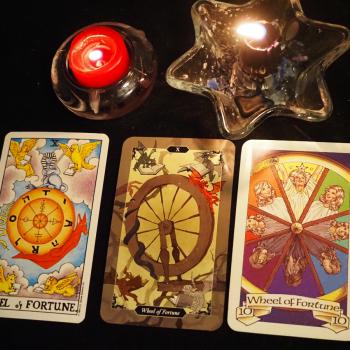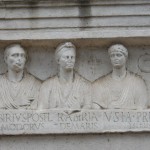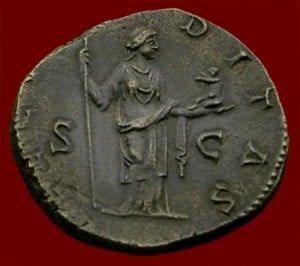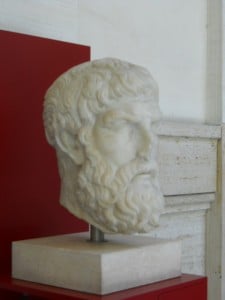Tradition is never static. It flows with many currents in and around obstructions, sometimes even in contradictory directions. Little pools may form at high water, becoming separated later from the main stream, just as sects may break off from a tradition, only to stagnate and eventually dry up, but the mainstream tradition continues to evolve, adapt, adopt as it moves further on. Rather than looking backward on a fixed time in the history of a religious tradition, often time it is the tradition itself that becomes the mechanism of innovation. Living according to tradition does not mean doing things in exactly the same way as had been done generations earlier. Religious tradition is not a unchanging set of beliefs, nor is it a set of rituals to be rigidly followed. Religion is a way of life. As such, it tends to evolve along with the life of its community. In the religio Romana we call our tradition the mos Maiorum, or “the way of the ancestors.” Just as today’s Jewish communities may look to their legends in the texts they preserved, we look at the legends and histories of Livius and Tacitus, the works of Ovidius, Plinius, and Valerius Maximus, and especially the works of Vergilius Maro, as well as later commentaries on such works, as these now preserve what was once the mos Maiorum.

The first thing to understand about the Religio Romana is that it originated from an ecstatic tradition. The legendary founder of our tradition, Numa Pompilius, consulted Egeria while establishing the religious institutions of Rome. She was said to have been a nymph in the sacred grove Carmenta at the foot of the Capitoline Hill. Or perhaps Egeria was a priestess of Carmenta, one of the vates who communicated with the Gods while under trance in the same way as Albunea, the White Sibyl, or like the Sibyl of Cumae, or even as Carmenta herself had done. Egeria instructed Numa on how to invoke the Gods in order that They might instruct him Themselves. The legends are very clear that Numa consulted Egeria in his dreams, and he invoked the Gods during incubation rites. He withdrew himself into sacred groves near a spring, to perform his sacrifices before lying down to receive visions by which the Gods instructed him on what festivals to hold, when to hold them, what rituals to perform, and what sacrifices to offer. That is, Numa Pompilius is credited with first establishing the Roman ritual calendar, the rituals to be performed on festival days, and instituting the various priesthoods in sacerdotal colleges that oversaw the calendar and rituals to benefit the Roman state. He set these instructions down as religious laws directly from the Gods for those who would follow after him. In this Numa was like Moses receiving the laws of his Adonai and like Mohammed when he was instructed by Allah. In a sense, too, Numa Pompilius represents the transition from the ecstatic tradition in which women played the major role to an established male-dominated priesthood for the Roman state. In this the legends of Numa parallel developments in India with the establishment of the Brahmans, represented in the Upanishads, over the earlier Rig Veda where women played a larger role in an ecstatic tradition. Likewise, the Roman state religion came later to emphasize ritual formality with a need for specialists in ritual forms, just as occurred with the Brahmans. The Roman state continued certain rituals even after they had forgotten the meaning of the words spoken during the rituals.
This leads me to point out two errors that I have seen in historical descriptions of the religio Romana and in attempts to reconstruct its tradition. First, and perhaps most importantly, is the neglect and sometimes the rejection of the role of women in the religio Romana. Secondly is a neglect and often times the rejection of the ecstatic element of the tradition. The latter may be due to an unfamiliarity with trance and ecstatic traditions. The first error is due in part to our available sources being male authors, our historians primarily being male in centuries past, and to the prejudices of the Christian copyists who preserved the ancient texts. Both errors, though, result from the focus that has been placed on the state religion of Rome without considering the state religion in context with the religio populi Romana itself. The state religion could certainly influence developments in the religious practices of the people of Rome. Augustus was able to reorganize the City into vici, replacing the older curiae, and introduce the Lares Augustales into the neighborhood shrine of a vicus. Bronze statues and painted images of the Lares Augustales appear in private homes. But much more often, throughout the Republican eras at least, the driving force behind the evolution of the traditions of Rome arose from the people. This included foreign cults adopted by patrician families, as with Castor and Pollux and with the rites of Hercules at the Ara Maxima. It included the eventual acceptance by the patricians of the plebeian religious institutions into the state religion, along with acceptance of plebeians into the state’s sacerdotal colleges by 300 BCE, and continued with further developments as more people entered into the plebeian ranks, bringing along their own Italic traditions. There was the adoption of private temples and altars, as with the Temple of the Bona Dea that was founded privately at first by Vestal Virgin Licinia, and later reinstituted by Livia Julia Augusta. And again there was the state’s adoption of private games like the Ludi Terentini that Augustus transformed into the Ludi Saeculares. Also an important factor in changes to Rome’s religious traditions was the army. Victorious generals vowed new temples and games, and at times carried off foreign deities whom they installed in Rome. Thus the Etruscan Goddess Vei was installed as Juno Regina on the Aventine and the Carthaginian Goddess Tanit was led to Rome as another Juno Regina, where as Juno Sospita had previously been the protective Goddess of a Latin city. From very early in Rome’s history merchants, both native and foreign, likewise introduced new deities, new forms of cultus, and new ideas that percolated up through the Roman populace to evolve the state’s religions all the more.
The Roman state’s religious institutions may be the most visible in the ruins of its edifices and in the few records to survive. While these may serve as a traditional guide on some aspects of what was once the mos Maiorum they are as unrelated to the modern reconstruction of the Religio Romana among cultores Deorum as the regulations on temple sacrifices in the historical cultus of Jerusalem is to today’s Judaism. The Book of Jubilees, the Vayikra (Leviticus), and Bamidbar (Numbers) preserve practices of the past and thus provide some insight into Judaic traditions, but not to Jewish practice of today. In the same way we should look at the mos Maiorum as a way of gaining insight into the Roman tradition, but the application of the tradition will necessarily have to apply to today’s circumstances. There is no longer a Roman Empire, and thus the imperial cults and the state apparatus no longer apply to modern cultores Deorum Romanorum. Stripped of those elements, what remains is the religion of hearth and home, of the family, and of small communities of cultores Deorum.















